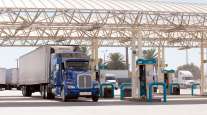Southwestern Pennsylvania Regional Freight Movement Expected to Increase 40% by 2040

The 10-county southwestern Pennsylvania region can expect the amount of freight moving into and out of the area to increase by 40% by 2040.
That’s the conclusion of a 104-page assessment of the freight industry released last month by the Southwestern Pennsylvania Commission. The assessment doesn’t make specific recommendations for improvements to accommodate the growth, but it encourages regional officials to monitor the need for additional layover areas for truckers and more multimodal facilities as well as monitoring the condition of locks and dams in case they deteriorate and can no longer allow barges to move as much material as they do now.
Based on 2011 figures, the study said the region moved 201 million tons of freight annually — 71 million tons shipped out, 83 million tons brought and 48 million tons transported within the region. The material was valued at $124.5 million.
By 2040, the study estimated, the regional freight industry will move 282 million tons of material worth $255 million. The amount of material being shipped out is expected to surpass material coming in — 105 million tons compared with 103 million tons — and the amount of material shipped within the region will grow to 73 million tons.
Sara Walfoort, the commission’s manager for freight planning, said area roads should be able to handle the growth. The region may need additional rest areas for truckers near interstate highway hubs such as New Stanton, Cranberry and Pittsburgh International Airport.
“Physically, I think the road system can accommodate the growth,” she said. “Doing it safely and efficiently is another question.”
Walfoort and Doug Smith, the agency’s transportation director, said it will be important to establish better communication with truckers so they can know hours in advance where space exists for them to spend a layover and that material shipped on rivers isn’t forced onto trucks by poor conditions at locks and dams.
Smith estimated one barge carries as much material as 15 railcars or 1,000 trucks.
Two other areas in the freight industry also should be monitored, they said, one nationally and one regionally.
The increase in online shopping could mean tractor-trailers making more deliveries to warehouses for residential distribution by smaller trucks instead of tractor-trailers delivering to retail outlets. That could reduce the number of shoppers going to retail outlets, too.
In Beaver County, the construction of Shell Chemical Co.’s multibillion-dollar cracker plant in Potter and where ancillary businesses locate around it could cause traffic disruptions. Shell has identified a staging location for large components of the construction project in Aliquippa and a regular route to get the material to the plant, but as many as 6,000 employees could be working on the construction site.
“Where the spin-off businesses develop will determine where the [transportation] needs will be,” Walfoort said.




